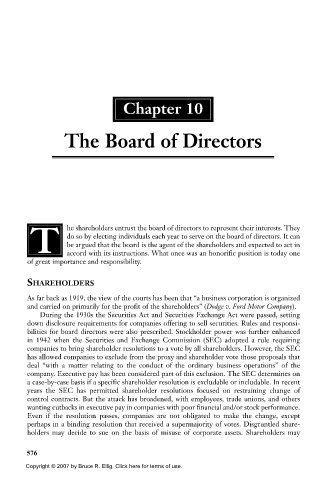Page 590 - Bruce Ellig - The Complete Guide to Executive Compensation (2007)
P. 590
Chapter 10
The Board of Directors
T he shareholders entrust the board of directors to represent their interests. They
do so by electing individuals each year to serve on the board of directors. It can
be argued that the board is the agent of the shareholders and expected to act in
accord with its instructions. What once was an honorific position is today one
of great importance and responsibility.
SHAREHOLDERS
As far back as 1919, the view of the courts has been that “a business corporation is organized
and carried on primarily for the profit of the shareholders” (Dodge v. Ford Motor Company).
During the 1930s the Securities Act and Securities Exchange Act were passed, setting
down disclosure requirements for companies offering to sell securities. Rules and responsi-
bilities for board directors were also prescribed. Stockholder power was further enhanced
in 1942 when the Securities and Exchange Commission (SEC) adopted a rule requiring
companies to bring shareholder resolutions to a vote by all shareholders. However, the SEC
has allowed companies to exclude from the proxy and shareholder vote those proposals that
deal “with a matter relating to the conduct of the ordinary business operations” of the
company. Executive pay has been considered part of this exclusion. The SEC determines on
a case-by-case basis if a specific shareholder resolution is excludable or includable. In recent
years the SEC has permitted shareholder resolutions focused on restraining change of
control contracts. But the attack has broadened, with employees, trade unions, and others
wanting cutbacks in executive pay in companies with poor financial and/or stock performance.
Even if the resolution passes, companies are not obligated to make the change, except
perhaps in a binding resolution that received a supermajority of votes. Disgruntled share-
holders may decide to sue on the basis of misuse of corporate assets. Shareholders may
576
Copyright © 2007 by Bruce R. Ellig. Click here for terms of use.

